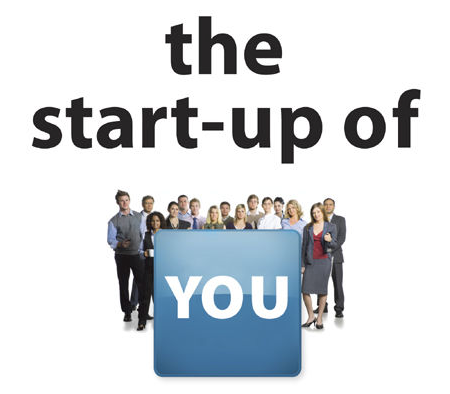The Start-Up of You
Quotes and Notes
Adapt to the Future, Invest in Yourself, and Transform Your Career
by Reid Hoffman and Ben Casnocha
 https://www.thestartupofyou.com
https://www.thestartupofyou.com
DISCLAIMER: This is really plenty of quotes, really, so, all credit to the authors.
All humans are Entrepreneurs
We must be constantly evolving, learning, adapting, all the time. Considering choices involves measuring risks, with not enough information, so we need to learn how to manage uncertainty.

Companies don’t want to invest in you, in part because you’re not likely to commit years and years of your life to working there — you will have many different jobs in your lifetime.
- No more long term pact between employer and employee.
Professional loyalty now flows “horizontally” to and from your network rather than “vertically” to your boss.
- No more searching for a new job when you are unemployed or unhappy with current job.
- Always try to generate new opportunities instead of looking for a new job.
When you start a company, you make decisions in an information-poor, time-compressed, resource-constrained environment. There are no guarantees or safety nets, so you take on a certain amount of risk.
- Adapt and embrace change, all the time.
The Start-up of You Mind-set: Permanent Beta.
- “It’s still Day 1”
- Test phase helps maintaining a sense of urgency
Though we are optimistic, we must remain vigilant and maintain a sense of urgency.
- A product is never finished, it always evolves.
For many people “twenty years of experience” is really one year of experience repeated twenty times. If you’re in permanent beta in your career, twenty years of experience actually is twenty years of experience because each year will be marked by new, enriching challenges and opportunities. Permanent beta is essentially a lifelong commitment to continuous personal growth. Get busy livin’, or get busy dyin’. If you’re not growing, you’re contracting. If you’re not moving forward, you’re moving backward.
- Continuous learning and feedback is key.
Develop a competitive advantage
Your understanding of: assets (what you already have), aspiration and values (where do you want to go?) and market realities (current market status) will help you achieve success.

For anything desirable, there’s competition
- Differentiate from competition.
- Customer centric culture becomes key part of the product you are selling.
“A company hires me over other professionals because …” How are you first, only, faster, better, or cheaper than other people who want to do what you’re doing in the world? What are you offering that’s hard to come by? What are you offering that’s both rare and valuable?
- Try to be the best in something.
- Don’t try to be best in everything.
Your competitive advantage is formed by the interplay of three different, ever-changing forces: your assets, your aspirations/values, and the market realities.
- Assets, aspirations and market realities may not be well known by you, but you must discover them by “doing”.
Assets is what you have right now.
- It’s your starting point in every possible way, in what is related to the business you are trying to get in.
You have two types of career assets to keep track of: soft and hard.
- Soft: Can’t be traded (knowledge, connections, skills, strengths).
- Hard: Whatever you can list on a balance sheet.
Aspirations include your deepest wishes, ideas, goals, and vision of the future … Aspirations and values are both important pieces of your career competitive advantage quite simply because when you’re doing work you care about, you are able to work harder and better.
- On motivation: Passion wins over making money, always, long term.
You remake yourself as you grow and as the world changes. Your identity doesn’t get found. It emerges.
- Aspirations helps defining you, but actions also modifies these aspirations.
Market realities: … a product won’t make money if customers don’t want or need it.
- You need to find a paying market for your assets.
The success of all professionals — the start-up of you — depends on employers and clients and partners choosing to buy your time. … Markets that don’t exist don’t care how smart you are.
- You need to fulfil a need (from customers, coworkers, boss, etc.) in order to success.
A good career plan accounts for the interplay of the three pieces — your assets, aspirations, and the market realities.
- All three pieces need to fit: Being good (and passionate) at something may not be enough. That “something” needs to be a real need (market reality).
Place yourself in a market niche where your existing assets shine brighter than the competition’s.
- Choose the battle wisely.
Think about how you’re currently adding value at work. If you stopped going to the office suddenly, what would not get done? What’s a day in the life of your company with you not there? That may be where you’re adding value. … Think about the things people frequently compliment you on — those may be your strengths.
- This is a clear and clever way to have a self picture of your current career status.
Plan to Adapt
You need to be “flexibly persistent”, and have an ABZ planning, this will help you making choices embracing risks, moving towards your target, learning (by actually “doing”) down the road.

Should you follow a plan or stay flexible? Should you listen to your heart or listen to the market? The answer is both. … The successful ones do both. They are flexibly persistent: they start companies that are true to their values and vision, yet they remain flexible enough to adapt.
- Being able to stay flexible and firm at the same time is key.
“The reason I don’t have a plan is because if I have a plan I’m limited to today’s options”. … Winning careers, like winning start-ups, are in permanent beta: always a work in progress.
- Again: Flexibly persistent is the approach.
Plan A is what you’re doing right now. It’s your current implementation of your competitive advantage. … Plan B is what you pivot to when you need to change either your goal or the route for getting there. … So what’s your certain, reliable, stable plan if all your career plans go to hell or if you want to do a major life change? That’s Plan Z. … The certainty of Plan Z is what allows you to take on uncertainty and risk in your Plans A and B.
- ABZ planning makes you eager to embrace changes and take risks.
Make Plans Based on Your Competitive Advantage. … Career plans should leverage your assets, set you in the direction of your aspirations, and account for the market realities. … “I believe I am skilled at X, I believe I want to do Y, I believe the market needs Z.”
- Again, choose your battle wisely. Your assets should shine against other’s, addressing a real need.
Real planning means plotting the specific steps it will take to make those aspirations happen. … Prioritise Learning … Technology companies focus on learning over profitability in the early years to maximise revenue in the later years. … “Which plan offers the most learning potential?” … Learn by Doing.
- Learning means you are trying to be better (including trial / error cicles, by actually “doing”), which enlarge your non-tradable assets.
Entrepreneurs penetrate the fog of the unknown by testing their hypotheses through trial and error. … Make Reversible, Small Bets. … ABZ Planning embraces recoverable failure so long as it generates real lessons.
- Taking risks by making choices enforces “learning by doing” practice.
- All backed up by ABZ planning gives you the courage to take risks, which makes you move forward.
Maintain an Identity Separate from Specific Employers. This way, you’ll have a professional identity that you can carry with you as you shift jobs.
- Your current job should not define you. You should define yourself beyond your current job.
PLAN B: PIVOT AS YOU LEARN … changing direction or changing your path to get somewhere based on what you’ve learned along the way. … Once you’ve pivoted and are on a new track, that becomes your new Plan A.
- Pivoting to plan B as a way to embrace trial / error (and learning) cycles
When to Pivot: To Pursue Upside or Avoid Downside. … It’s better to be in front of a big change than to be behind it. … The common presumption is that you shift to Plan B when something isn’t working. That’s frequently the case but not always. … If you find that the grass really is greener somewhere else, go there!
- Don’t wait until Plan A starts failing to move into Plan B: Your guts should help to make this choice too (based on previous learnings).
Where to Pivot: To an Adjacent Niche, Something Different but Related. … The best Plan B is different but very much related to what you’re already doing.
- Your assets should still shine on the new battle of choice.
How to Pivot: Start It on the Side. … Companies ranging from 3M to Gore-Tex, Google to LinkedIn, pay employees to spend a portion of their time experimenting on side projects. Why not make this a personal career policy?
- Consider time for a side project a must in your private professional life.
PLAN Z: JUMP ON YOUR LIFEBOAT AND REGROUP … The reason many people do not embrace trial and error, learning by doing, adaptation, and the other themes of this chapter is because these strategies introduce real uncertainty. … The certainty of the Plan Z backstop is what enables you to be aggressive — not tentative — about Plans A and B.
- Hopefully you never need to go with Plan Z (which must be real), it’s supposed to be there to help you being aggressive by taking risks when making choices (pivoting).
It takes a Network
The “you” in the book title means “I” and also “We”. You need to be able to build genuine relationships, measuring the strength of your network, and always try to give something in order to get something. Your network will help you as long as you are able to to give something to it.

VCs will frequently back stellar founders with a so-so idea over mediocre founders with a good idea, on the belief that smart and adaptable people will manoeuvre their way to something that works.
- Founder abilities and connections wins over ideas.
If you want to accelerate your career, you need the help and support of others. … If you study the life of any notable person, you’ll find that the main character operates within a web of support.
- Your network of connections is your web of support, you need that.
And one bad apple on an otherwise top-notch team can spoil the whole bunch. Research shows that a team in the business world will tend to perform at the level of the worst individual team member.
- Keep an eye on the general level of your team.
Relationship builders, on the other hand, try to help other people first. They don’t keep score. They’re aware that many good deeds get reciprocated, but they’re not calculated about it. … Relationship builders prioritise high-quality relationships over a large number of connections. … Empathise and Help First, seeing the world from the other person’s perspective thinking about how you can help and collaborate with the other person rather than thinking about what you can get from him or her.
- Helping others helps yourself, long term.
- Quality of connections wins over quantity.
Reject the misconception that if you’re less powerful, less wealthy, or less experienced, you have nothing to offer someone else. Everyone is capable of offering helpful support or constructive feedback. To be sure, you’ll be most helpful if you have the skills and experiences to help your allies. … Best-connected professionals are ones who can really help their allies.
- You should always feel being able to help others. There is always something you can bring on the table.
Set up an “Interesting People” Fund.
- Based on your own interests, which may help you understand: your assets, vision / values, and market realities. Wherever you want to battle in.
Pursue Breakup Opportunities
Curiosity it’s a must, and mixing it with actually “doing” things helps you to build these “breakup opportunities”.

while others simply complain, entrepreneurs ask Why?. … “The best way to ensure that lucky things happen is to make sure a lot of things happen.” … Make things happen, and in the long run, you’ll design your own serendipity, and make your own opportunities.
- Enable all this by actually “doing”.
Start your own mafia. … Be Resilient: When the Naysayers Are Loud, Turn Up the Music. … Great opportunities almost never fit your schedule.
- Your own mafia helps you being resilient.
- Don’t always wait for “the right moment”.
Take Intelligent Risks
Embrace change by learning to measure risks, in an environment full of uncertainty.

making a decision reduces opportunities in the short run, but increases opportunities in the long run. To move forward in your career, you have to commit to specific opportunities as part of an iterative plan, despite doubt and despite inconvenience.
- Making decisions involve taking risks, which are backed by learnings, which you only get by actually “doing”.
There’s competition for good opportunities. And because of that, if you can intelligently take on risk, you will find opportunities others miss. … We are all risk takers. But we are not all equally intelligent about how we do it. … Many people think you get career stability by minimising all risk. But ironically, in a changing world, that’s one of the riskiest things you can do.
- Embracing change by making choices involves risks, we should not avoid that, we should instead learn to handle that.
Most people overrate risk. At our core we humans are wired to avoid risk. We evolved this way because to our ancestors, it was more costly to miss the sign of a predator (threat) than to miss the sign of food (opportunity). … Mother Nature evolved a brain that routinely tricked them into making three mistakes: overestimating threats, underestimating opportunities, and underestimating resources. … You’ll never be fully certain. Don’t conflate uncertainty with risk. … Uncertainty is an ingredient of risk.
- You need to (constantly) learn to embrace and handle uncertainty
While you don’t want to make career moves on 0 percent information, you also don’t want to wait till you have 100 percent information — or else you’ll wait forever.
- You need to learn to measure uncertainty too, avoid crazy decisions, but also avoid waiting for “the perfect time” to take a decision.
Consider age and stage. … As you age and build more assets, your risk tolerance shifts.
- Consider how much risk you want to handle.
Jobs that pay less in cash but offer tremendous learning. … Part-time or contract gigs that are less “stable” than full-time jobs. … Hiring someone without much experience but who’s a fast learner and much cheaper. … An opportunity where the risks are highly publicised.
- There are plenty of different types of scenarios where risk can be lower than usually considered, and trade-offs of making a change can be really positive for your career
The Volatility Paradox: Small Fires Prevent the Big Burn … The way to intelligently manage risk is to make yourself resilient to these shocks by pursuing those opportunities with some volatility baked in. … How you gather, manage, and use information will determine whether you win or lose
- You want to handle small fires, in order to be more resilient to big fires down the road.
Gathering intelligence: actionable, timely information on all facets of their business, including industry trends, opportunities, competitors’ activities, customer sentiment, promising young talent, and sales trends. In a business, intelligence serves as a GPS device.
- Analyse all the information you have at your hands, in order to reduce uncertainty and make the next move.
Who you know is What you know
Your network of connections puts collective intelligence at your hands, you should take advantage of it.

It’s people who help you understand your assets, aspirations, and the market realities; it’s people who help you vet and get introduced to possible allies and trust connections; it’s people who help you track the risk attached to a given opportunity. … Pose Questions to Your Entire Network … Domain experts. These are the pros, the people who really know the topic at hand. … Ask Good Questions. … Converse, don’t interrogate.
- Take advantage of the collective intelligence already there for you: Your network of connections.
Conclusion
Remember that the “You” in Start-Up of You is both singular and plural.

The career escalator is permanently jammed. The employer-employee pact is dissolving. Competition for opportunity is fierce. … Allies help you develop a competitive advantage, do ABZ planning, pursue breakout opportunities, take intelligent risks, and tap network intelligence. … Start tapping into your network. Start investing in skills. Start taking intelligent risks. Start pursuing breakout opportunities. But most of all, start forging your own differentiated career plans; start adapting these rules to your own adaptive life.
- Yup, that’s it (: